What are Perennial Weeds?
Perennial Weeds are longer lived plants that can survive winter or regrow from roots, rhizomes or tubers in spring after a period of dormancy. Many weeds that grow from seed ...

 Weeds may be green, but they are plants growing where they’re not wanted within your lawn.
Weeds may be green, but they are plants growing where they’re not wanted within your lawn.
Weeds can take any form and can vary depending on where they grow and typically produce large numbers of seeds, assisting their spread.
Unfortunately, weeds are often excellent at surviving and reproducing and are commonly the first plants to colonise and dominate.
In our full guide below, myhomeTURF offers lawn lovers a comprehensive guide that helps identify Common Lawn Weeds and gives guidance on prevention, control & best herbicides to use.
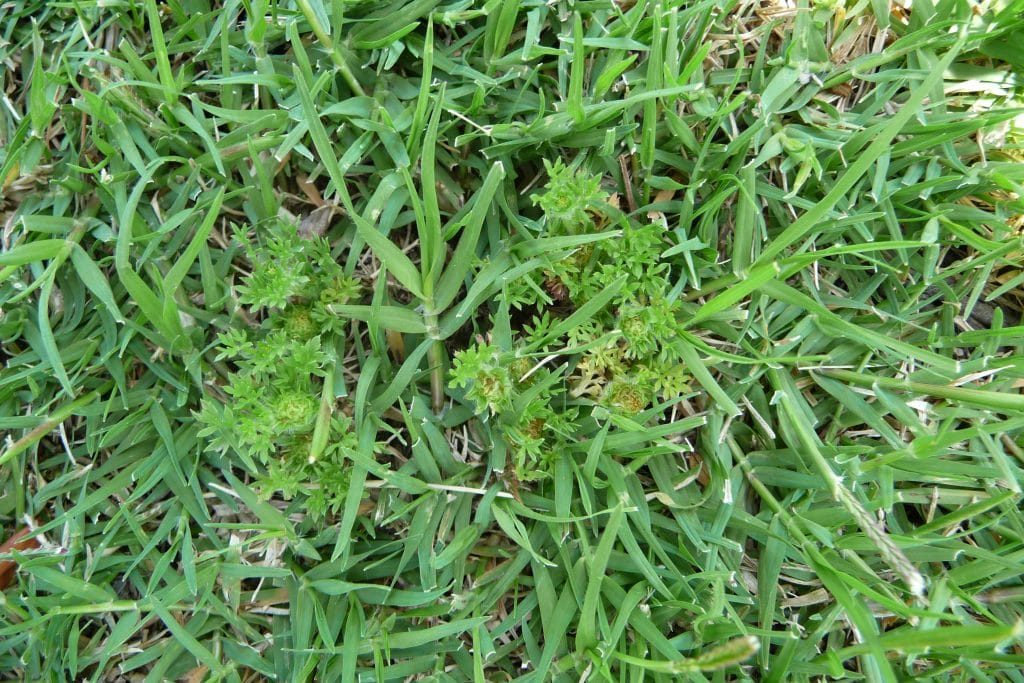 Bindi Weed is a broadleaf winter annual that is also known as Lawn Burweed and Spurweed.
Bindi Weed is a broadleaf winter annual that is also known as Lawn Burweed and Spurweed.
It is a very invasive, low growing weed that produces bur-like fruit that poses a hazard to humans and animals due to their sharp edges.
The weed evolves during winter and develops carrot-like leaves, during spring it produces a single flower that matures to form a prickly seed pod with three spines.
The best time to remove Bindi Weeds is during late winter or spring.
If you only have a small amount of Bindi in your lawn, then hand removal is suitable if you remove the plant along with the roots.
If your lawn is rife with Bindi, then myhomeTurf recommends a Broadleaf Weed Herbicide with the Common Active Ingredients of Clopyralid, Diflufenican and Potassium Salt.

Bow and Arrow 500mL is one of the most effective broadleaf liquid herbicides on the market. Suitable for Zoysia, Kikuyu, Couch and Buffalo grasses however transient discolouration may occur on Kikuyu, Carpet and Queensland Blue Couch lawns. Always read the safety directions and instructions on the product label before use.
SHOP NOW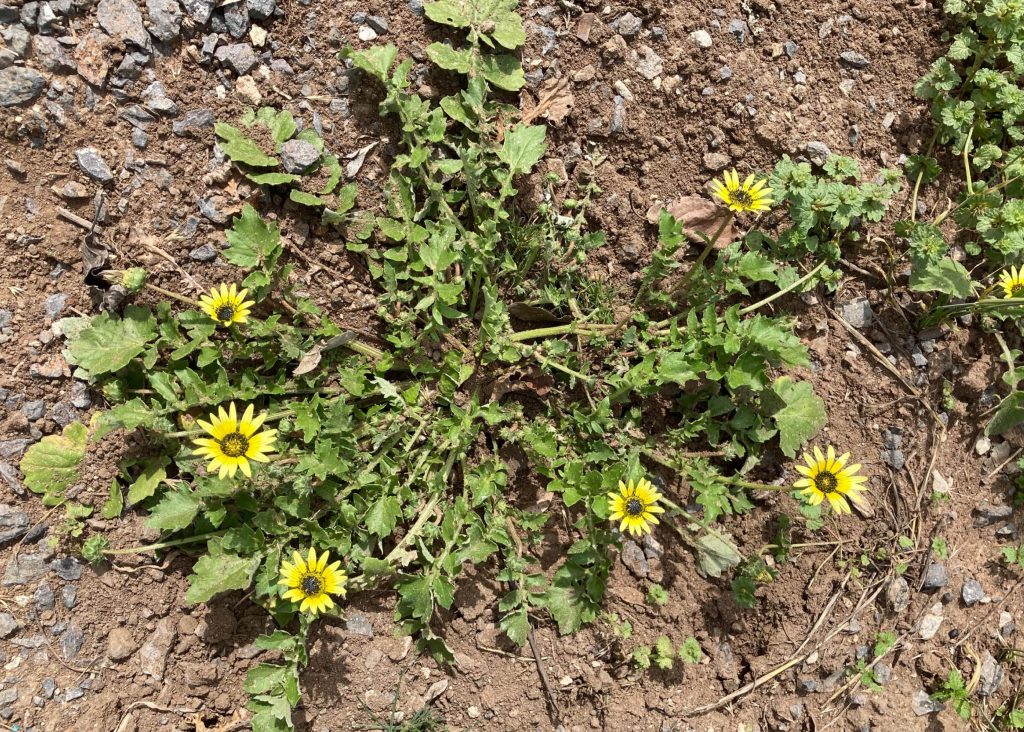 Capeweed is a low-growing annual herbaceous plant that is common in gardens, lawns, sports fields, footpaths, roadsides, horse paddocks and on farmland and natural grasslands.
Capeweed is a low-growing annual herbaceous plant that is common in gardens, lawns, sports fields, footpaths, roadsides, horse paddocks and on farmland and natural grasslands.
The pale yellow petals on the daisy-like flowers are green or purplish on the back and the flower heads have dark purplish centres made up of tiny tubular flowers.
Seeds can survive in the soil for up to seven years.
The best time to tackle Capeweed is in spring when both weeds and turf are actively growing, but before the weed flowers.
Look for selective post-emergent herbicides containing the active ingredient Iodosulfuron-Methyl Sodium, a blend of Dicamba and MCPA or even a three-way mixture of Clopyralid, Diflufenican and MCPA.
Before using any herbicide, check product labels to make sure they’re suitable for the type of grass you have and follow the instructions and safety directions.
You can purchase the following products through the myhomeTURF online store.

Turf Culture Bow and Arrow 500ml liquid herbicide offers outstanding control of Capeweed at low application rates. It may take 10 days or more to see results. Bow and Arrow is suitable for use on Zoysia, Kikuyu, Couch and Buffalo grasses. It may cause temporary discolouration of Kikuyu, Carpet and Queensland Blue Couch lawns.
SHOP NOW
Indigo ProForce Contra M 1L is a reliable, selective liquid herbicide registered for the control of Capeweed in Zoysia, Kikuyu and Couch grasses. It is not suitable for Buffalo lawns.
SHOP NOW
Indigo Duke 100WG 100gm is a Group B liquid herbicide suitable for post-emergent control of Capeweed in Kikuyu, Buffalo and common and hybrid Couch. It is not suitable for Queensland Blue Couch or Zoysia grasses.
SHOP NOW Crabgrass is one of the worst lawn weeds in the world, and when found the homeowner should never hesitate in removing or killing it as soon as possible.
Crabgrass is one of the worst lawn weeds in the world, and when found the homeowner should never hesitate in removing or killing it as soon as possible.
Due to the severity of Crab Grass weed and how fast it can spread, it simply must not be ignored.
Crabgrass is easily known by most people, it is most noticeable by its wide leaf blade and grass-like appearance.
This grass, however, will send out tough stems with fingers of seed heads at its tips. Crabgrass will become most prominent when it’s leaf blades grow faster than the surrounding lawn and when it reaches out and become taller than the other turf.
The seed production of Crabgrass is extremely prolific. Every season, a single weed can send out thousands of seeds, so it’s easy to see how it can quickly spread and take-over and ruin an entire lawn.
Ongoing control of Crabgrass involves regular year-round lawn mowing which will aid in constantly removing new weed seeds as they are produced and before they mature.
If you need to use a herbicide, myhomeTURF recommends a pre-emergent herbicide with the Common Active Ingredient of Oxadiazon.

Crowsfoot Grass is a hardy annual weed that grows during spring, summer and autumn.
It is a tufted, short-lived, grass with spreading of semi-upright stems growing up to 60cm tall.
Crowsfoot has leaf sheaths that are prominently keeled with a membranous structure (5cm to 10cm long) at the base of the leaf blade.
Its narrow leaf blades (3cm to 35cm long and 30cm to 80cm wide) are mostly hairless.
Crowsfoot Grass has seed-heads with 1-15 branches (3.5cm to 15.5cm long) that radiate outwards from the same point.
Numerous flower spikelets (35cm to 70cm long) are densely arranged along the seed-head branches.
Crowsfoot grows in all soil conditions and can survive in heavily compacted areas where Couch grass won’t grow and may survive for more than a year in climates not subject to frost
This low-growing weed is capable of setting seed even when closely mown.
For the control of Crowsfoot, myhomeTURF recommends a pre-emergent herbicide with the Common Active Ingredient of Oxadiazon.
 Dandelions have green leaves edged with teeth’ that grow mostly flat to the ground and are distinguished by their bright yellow flowers that fade to form a white puffball.
Dandelions have green leaves edged with teeth’ that grow mostly flat to the ground and are distinguished by their bright yellow flowers that fade to form a white puffball.
They appear in spring and autumn in lawns that aren’t as full and healthy as they could be.
Above-ground, Dandelion seeds ride the wind currents, and drop into the slightest opening in your lawn and propagate.
Below-ground, the Dandelion weed lays down a taproot up to 25cm long however, pulling the taproot as a means of removal is problematic.
The Dandelion’s thick, brittle roots easily split, and any fraction left behind will regenerate.
With careful digging and pulling the Dandelion weed can be removed by hand.
Using post-emergence herbicides (referred to as broadleaf weed control) are the most effective dandelion killers that are safe for lawns. The Common Active Ingredient 2,4-D is an example of a selective and systemic post-emergent herbicide.
 Khaki Weed grows in all but the driest environments.
Khaki Weed grows in all but the driest environments.
Also known as Khaki Burr, it thrives in disturbed soil, quickly forming a dense mat of vegetation in lawns, orchards, along roadsides and on nature strips.
Its clusters of green or pale yellow flowers will develop into sharp burrs that that readily attach to animals, socks, trousers and vehicles, as well as being spread by moving water or in lawn clippings.
Fragments of stem can also take root and generate new plants.
There are several herbicides suitable for controlling Khaki Weed. Some contain a single active ingredient while others have a combination of two or three.
Look for products containing Bromoxynil, Iodosulfuron-Methyl Sodium, Dicamba, Clopyralid, Diflufenican and MCPA.
Always wear the appropriate protective equipment – gloves, safety glasses etc… – and read the product label before using any herbicide.
Also check whether the product is suitable for use on your grass type.
Some labels will recommend adding a surfactant, also known as a wetting agent, to the mixed weed killer to improve spray coverage and boost its effectiveness.
You can purchase the following products through the myhomeTURF online store.

Indigo BroadForce MA 500mL is a dual-action selective broadleaf liquid herbicide for the control of Khaki Weed, Bindii, Creeping Oxalis, Thistles and Clover. It is suitable for use on Kikuyu, Couch and Buffalo grasses.
SHOP NOW
Indigo ProForce Contra M 1L is a reliable, dual-action selective liquid herbicide for controlling a huge range of broadleaf weeds. It is suitable for use on Zoysia, Kikuyu and Couch grasses. It cannot be used on Buffalo lawns.
SHOP NOW
Bow and Arrow 500mL is a triple action liquid herbicide offering outstanding broadleaf weed control at low application rates. It is suitable for use on Zoysia, Kikuyu, Couch and Buffalo grasses, but some temporary discolouration may occur on Kikuyu, Carpet Grass and Queensland Blue Couch lawns.
SHOP NOW Marshmallow is an annual Broadleaf weed with a fondness for disturbed sites in full sun on any soil type, especially in the southern states of Australia.
Marshmallow is an annual Broadleaf weed with a fondness for disturbed sites in full sun on any soil type, especially in the southern states of Australia.
It has rounded wrinkled leaves with prominent veins, and stems covered in stiff hairs.
Small pale flowers are produced from late autumn until spring, and it mostly reproduces from seed, which can lie dormant in the soil for many years. Older plants may resprout from the crown above the long taproot.
Marshmallow is resistant to glyphosate and best managed by using selective post-emergent herbicides, such as two or three-way mixes containing the active ingredients Dicamba and MCPA on small plants.
Before using any herbicide, check product labels to make sure they’re suitable for the type of grass you have and follow the instructions and safety directions.
You can purchase the following product through the myhomeTURF online store.

Indigo ProForce Contra M 1L is a reliable, dual-action selective liquid herbicide for controlling a huge range of broadleaf weeds. It is suitable for use on Zoysia, Kikuyu and Couch grasses. It cannot be used on Buffalo lawns.
SHOP NOW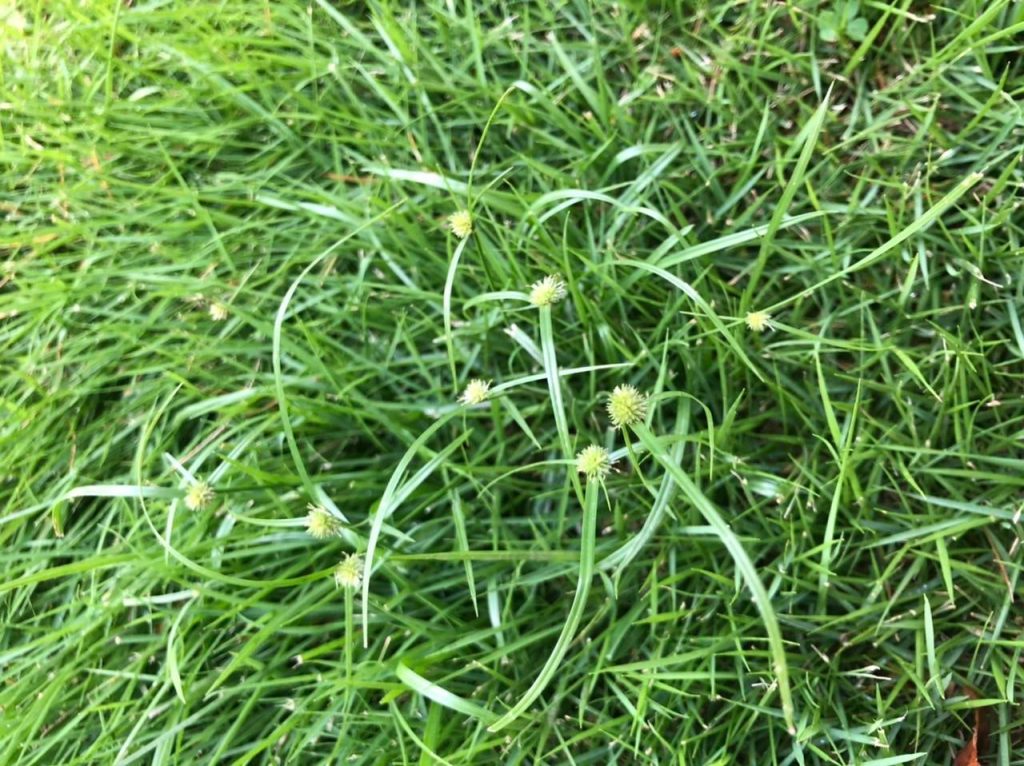 Mullumbimby Couch grows year-round and is a mat-forming grass-like plant with long underground runners and upright flowering stems measuring up to 40cm in height.
Mullumbimby Couch grows year-round and is a mat-forming grass-like plant with long underground runners and upright flowering stems measuring up to 40cm in height.
The weed has tough long, rhizomes which are red to purple in colour and stems that are triangular in cross-section.
Mullumbimby Couch has bright green leaves (10cm to 30cm wide) that are hairless and sheath the stem at the base.
Its pale green seed-heads (60cm to 70cm long) have three or four green leafy bracts at the base and contain numerous small flower spikelets which appear throughout spring and summer.
Mullumbimby Couch has ‘seeds’ yellow to reddish-brown in colour.
Conducive growing conditions for Mullumbimby Couch occur when there is excessive soil moisture and humidity.
Mullumbimby Couch is a member of the Sedge family and can quickly colonise areas of the garden by setting seed and underground rhizomes.
Control of Mullumbimby Couch is difficult. You can use a spade to remove the weed but ensure that no roots or bulbs are left in the soil or it will reappear.
Alternately for the control of Mullumbimby Couch, myhomeTURF recommends a selective herbicide with the Common Active Ingredient of Halosulfuron-methyl.

Indigo Halo-Force 750WG 25gm is a dry flowable granule Herbicide that disperses in water and can be used for selective post-emergence control of Mullumbimby Couch in your lawn. Suitable for Kikuyu, Couch and Buffalo grasses. Always read the safety directions and instructions on the product label before use.
SHOP NOW Nut Grass is a long-lived grass-like plant that is a member of the Sedge family and can be found in your lawn year-round.
Nut Grass is a long-lived grass-like plant that is a member of the Sedge family and can be found in your lawn year-round.
The weed usually grows to about 20cm to 50cm in height and produces a network of creeping underground stems with small tubers (100cm to 250cm long).
Nut Grass has upright flowering stems that are smooth and three-angled in cross section.
The weed has very narrow leaves (7cm to 20cm long and 20cm to 60cm wide) which are borne in a tuft at the base of the stems.
Its seed heads have three to eight branches that vary in length (up to 10cm long) and are supported by two to four green leafy bracts.
The easiest way to distinguish Nut Grass is through the branches which have several elongated reddish-brown or purplish-brown flower spikelets (100cm to 250cm long and 20cm to 25cm wide).
Nut Grass control is very similar to that of Mullumbimby Couch and is also difficult to control.
A spade can be used to remove the weed but ensure no roots or bulbs are left in the soil or it will reappear.
Alternately for the control of Nut Grass, myhomeTURF recommends a selective herbicide with the Common Active Ingredient of Halosulfuron-methyl.

Indigo Halo-Force 750WG 25gm is a dry flowable granule Herbicide that disperses in water and can be used for selective post-emergence control of Mullumbimby Couch in your lawn. Suitable for Kikuyu, Couch and Buffalo grasses. Always read the safety directions and instructions on the product label before use.
SHOP NOW Apart from its distinctive smell, Onion Weed is distinguished by its tall, thin leaves and mostly white bell-shaped flowers growing at the top of a long stalk.
Apart from its distinctive smell, Onion Weed is distinguished by its tall, thin leaves and mostly white bell-shaped flowers growing at the top of a long stalk.
Onion Weed seeds form in summer and autumn and are spread by wind, in soil and in water. Small bulbs develop from the main bulb and can produce new plants after the main bulb dies, making control difficult but not impossible.
There are several herbicides on the market suitable for managing Onion Weed.
Depending on the maturity and size of plants, and how large an area is affected, it may be necessary for you to spray more than once.
Look for products containing the active ingredient Iodosulfuron-Methyl Sodium or Glyphosate but take care to avoid glyphosate overspray getting on your lawn because it will kill any plant it touches.
Before using any herbicide, check product labels to make sure they’re suitable for the type of grass you have and follow the instructions and safety directions.
You can purchase the following products through the myhomeTURF online store.

Indigo Duke 100WG 100g is a simple to use granular herbicide for controlling a wide range of broadleaf weeds. It is suitable for use on Kikuyu, Buffalo and common or hybrid Couch grasses. It should not be used on Queensland Blue Couch or Zoysia grasses.
SHOP NOW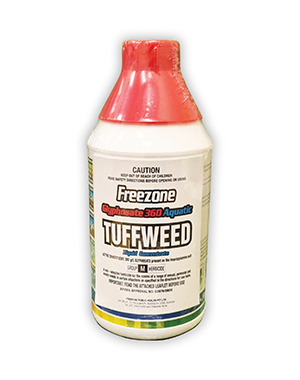
TUFFWEED Liquid Glyphosate 1L concentrate is a non-selective herbicide that combats the toughest of weeds. Any overspray will damage all types of lawns.
SHOP NOW
Oxalis can appear like a miniature clover plant, but it bears tiny yellow flowers.
Some gardeners occasionally grow Oxalis for groundcover but for most of us it is an annoying weed.
Oxalis is a perennial weed, which spreads through interlocking rhizomes that are easy to break apart, these rhizomes eventually produces tiny bulbils.
The seeds of Oxalis are prolific and ejected when ripe from tiny seed pods that look like mini okra.
Anywhere the stem touches the ground the Oxalis weed can root, potentially producing more and more plants.
Oxalis also forms a fleshy taproot and an extensive branching root system which can make it challenging to manage.
Hand removal can be done but it is slow and laborious, and it may take several seasons to remove the Oxalis from your lawn.
For the control of Oxalis, myhomeTURF recommends a pre-emergent herbicide with the Common Active Ingredient of Oxadiazon.
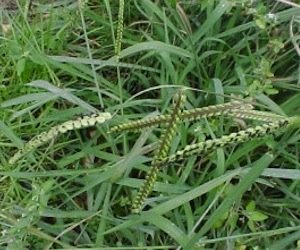 Paspalum is one of the most difficult weeds to control and predominantly found in the south-eastern states of Australia.
Paspalum is one of the most difficult weeds to control and predominantly found in the south-eastern states of Australia.
It is a long-lived tufted grass growing up to 1.5m tall with slightly folded leaf blades at the base which are usually hairless.
Paspalum’s seed-heads are borne at the tips of upright flowering stems and have 2-11 branches (2.5cm-11cm long) that are alternatively arranged along a main stalk.
Each Paspalum seed-head branch bears numerous small flower spikelets that are covered with hairs.
Paspalum mainly grows throughout the warmer months from late spring to autumn.
The weed prolifically spreads through its sticky seeds which easily grasp onto pets and shoes before been relocated.
Like with most weed control, removing by hand is the best method as long as the entire plant and roots are removed.
Alternately for the control of Paspalum, myhomeTURF recommends a pre-emergent herbicide with the Common Active Ingredient of Prodiamine.

Barricade 1L is a pre-emergent liquid herbicide that controls a wide range of weeds and is suitable for use on Zoysia, Kikuyu, Buffalo and Couch grasses. Always read the safety directions and instructions on the product label before use.
SHOP NOW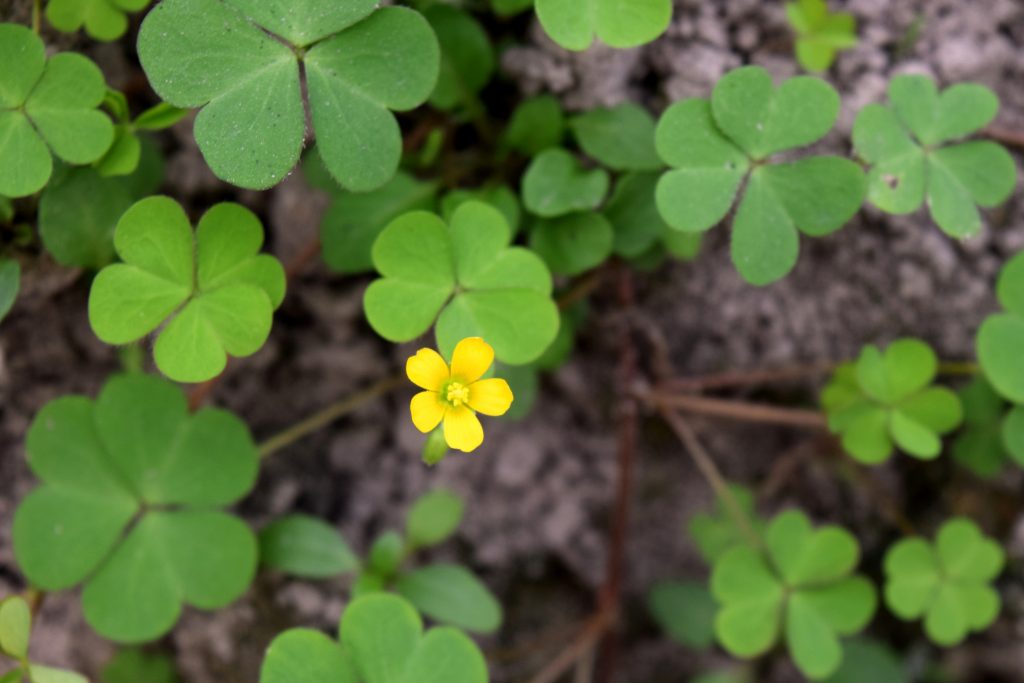 Soursob is a distinctive perennial herb with trifoliate heart-shaped leaves that often have dark spots.
Soursob is a distinctive perennial herb with trifoliate heart-shaped leaves that often have dark spots.
Its clusters of drooping bright yellow flowers have five petals and produce no seed. Plants reproduce by developing an underground network of up to 20 small secondary bulbs off a long white tap root.
Also known as Sour Grass and Bermuda Buttercup, it grows from May to September or later, if conditions remain cool and wet.
There are several herbicide sprays on the market that are suitable for managing Soursob.
Depending on the maturity of the plants and how large an area is affected, it may be necessary for you to spray more than once.
If you’ve had Soursob in your lawn in previous years, try using a pre-emergent herbicide containing the active ingredients Bromoxynil and MCPA or a pre-emergent herbicide and fertiliser product, such as Oxafert in late summer.
Spot spraying with glyphosate can be effective on Soursob, but as a non-selective herbicide it will poison everything it touches, including your lawn. Overspray of glyphosate is especially toxic to Kikuyu and Buffalo lawns.
It is safer to use a selective herbicide when plants are actively growing and not under stress.
The best time to spray is just before flowering, when older bulbs have put all their energy into the flowers and new bulbs haven’t yet been able to grow.
Before using any herbicide, check product labels to make sure they’re suitable for the type of grass you have and follow the instructions and safety directions.
You can purchase the following products through the myhomeTURF online store.

Bow and Arrow 500mL is a triple action liquid herbicide offering outstanding broadleaf weed control at low application rates. It is suitable for use on Zoysia, Kikuyu, Couch and Buffalo grasses, but some temporary discolouration may occur on Kikuyu, Carpet Grass and Queensland Blue Couch lawns.
SHOP NOW
Indigo BroadForce MA 500mL is a dual-action selective broadleaf liquid herbicide suitable for use on Kikuyu, Couch and Buffalo grasses.
SHOP NOW
TUFFWEED Liquid Glyphosate 1L super concentrate is a non-selective herbicide that combats the toughest of weeds. Any overspray will damage all types of lawns.
SHOP NOW
Summer Grass is a common fast-growing weed, found Australia-wide, that sends out shoots in all directions from its centre during conditions of high heat and humidity.
Summer Grass spreads prolifically through its stolons, with stems that can be brown or red in colour and thin grey-green leaves with fine spiky seed heads that shoot upwards.
When first noticed in your lawn, Summer Grass should be removed immediately by hand as it competes with your turf for nutrients and growing space.
Summer Grass goes to seed during autumn and if not controlled re-emerges the next year.
Competition is greatest from Summer Grass when it is thin and open, the mowing height is incorrect and light frequent irrigations are applied.
Once Summer Grass appears it is hard to control so prevention is the key and feeding your lawn with fertiliser will assist.
Therefore, for the control of Summer Grass, myhomeTURF recommends a pre-emergent herbicide with the Common Active Ingredient of Oxadiazon.
 Thistles are a herbaceous annual flowering weed known for their tall spiny stems and leaves and large, mostly purple, flowers.
Thistles are a herbaceous annual flowering weed known for their tall spiny stems and leaves and large, mostly purple, flowers.
They reproduce mainly via seeds which have fine hairs that can blow in the wind or attach to clothing or animals.
Thistles respond well to treatment by chemical herbicides. Herbicide use is most effective in autumn, when plants are at the seedling stage, before the flowering stem appears.
Look for selective products containing the active ingredients Dicamba and MCPA, or glyphosate but take care to avoid glyphosate overspray getting on your lawn because it will kill any plant it touches.
Before using any herbicide, check product labels to make sure they’re suitable for the type of grass you have and follow the instructions and safety directions.
You can purchase the following products through the myhomeTURF online store.

Indigo ProForce Contra M 1L is a reliable, dual-action selective liquid herbicide for controlling a huge range of broadleaf weeds. It is suitable for use on Zoysia, Kikuyu and Couch grasses. It cannot be used on Buffalo lawns.
SHOP NOW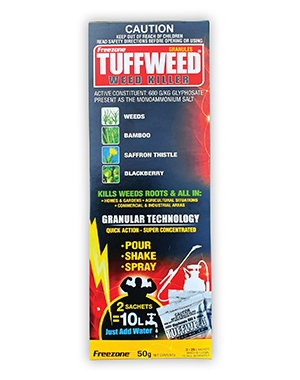
Freezone TUFFWEED 50g is a super concentrate non-selective herbicide for use on the toughest of weeds. It contains Glyphosate and any overspray will damage all types of lawns.
SHOP NOW
TUFFWEED Liquid Glyphosate 1L concentrate is a non-selective herbicide that combats the toughest of weeds. Any overspray will damage all types of lawns.
SHOP NOW White Clover is a classic three-leaf clover with bright green leaves adorned with white crescent shapes.
White Clover is a classic three-leaf clover with bright green leaves adorned with white crescent shapes.
It appears from spring through to autumn and usually in thin lawns with nutrient-poor soil.
White Clover grows in a creeping manner and will develop roots wherever a stem node touches the ground.
The flowers on White Clover are spiky and white with a brownish green centre.
If White Clover is established in your lawn you can start by hand removal.
However, if White Clover is prolific throughout your lawn then a pre or post-emergent herbicide is recommended but first check with your Local Garden Centre to ensure it is suitable for your lawn type.
It is important to note that killing White Clover weed is easy but killing the White Clover seed is not.
White Clover has seeds that can survive high heat, low temperatures and can stay dormant for years before germinating.
Therefore, be prepared to hand weed or, myhomeTURF recommends a pre-emergent herbicide with the Common Active Ingredient of Oxadiazon.
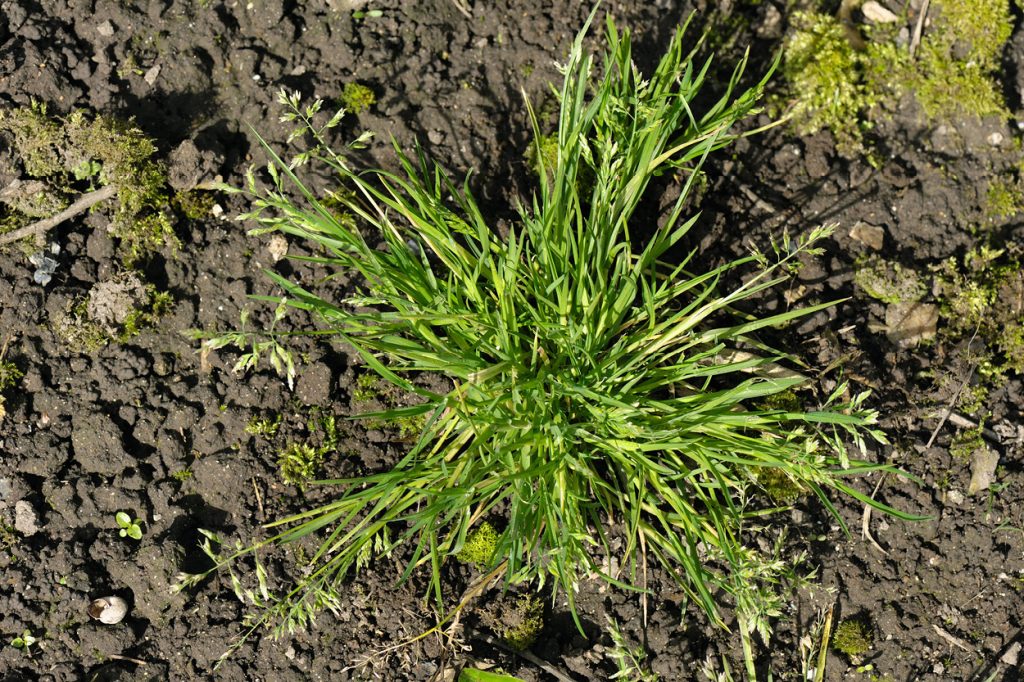 Winter Grass is a widespread weed problem throughout Australia and is more prevalent in winter and spring.
Winter Grass is a widespread weed problem throughout Australia and is more prevalent in winter and spring.
Winter Grass is characterised by its prolific seed production which makes it hard to manage.
If seeds appear, they are quick to germinate, and it is more than likely you will have Winter Green in your lawn again the following year.
The Winter Grass weed is a pale green colour with smooth leaves and has a white cotton-like root zone.
While Winter Grass is easy to remove my hand, as there is so much of it often it grows back.
There are two methods of controlling Winter Grass –post-emergent and pre-emergent herbicide control.
Post-emergent control is when you selectively poison out the Winter Grass weed after it germinates (for example, during the autumn and winter months).
The most important thing is to apply the post-emergent control exactly as directed. The herbicide can take a considerable amount of time to work, anywhere from between two weeks and two months.
If the post-emergent is applied too late into the winter, it can be hard to get a result.
Pre-emergent control works on the basis that you control the seed before it germinates which is an easier way to manage the problem. Application is usually going into winter.
myhomeTURF recommends a pre-emergent herbicide with the Common Active Ingredient of Oxadiazon.
The trick to preventing weeds from taking hold is to keep your lawn in good condition with a solid lawn care routine.
However, if you do find yourself in the position where you want to remove weeds from your lawn yourself, always remove seed heads from weeds and take care when digging them out to remove all of the roots. Watch our helpful video below for advice.